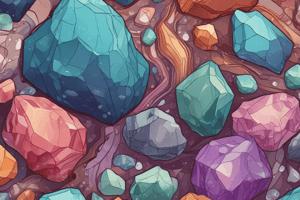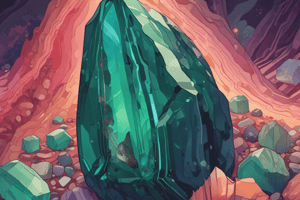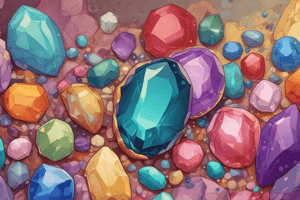Podcast
Questions and Answers
What is the characteristic of feldspar, spodumene, and diopside that requires protective settings?
What is the characteristic of feldspar, spodumene, and diopside that requires protective settings?
- Hardness
- Adularescence
- Brilliant spectral hues
- Cleavage in two directions (correct)
What is the characteristic of sunstone that gives it a reddish or golden sheen?
What is the characteristic of sunstone that gives it a reddish or golden sheen?
- Small inclusions (correct)
- Large inclusions
- Adularescence
- Labradorite type
What is the trade term for the vivid blue adularescence displayed by the finest moonstone?
What is the trade term for the vivid blue adularescence displayed by the finest moonstone?
- Blue sheen (correct)
- Adularescence
- Spectrolite
- Goldstone
What is the cutting style most commonly used for moonstone?
What is the cutting style most commonly used for moonstone?
What is the cause of moonstone's adularescence?
What is the cause of moonstone's adularescence?
What is the reason why kunzite's color can fade?
What is the reason why kunzite's color can fade?
Why is chrome diopside considered an effective emerald alternative?
Why is chrome diopside considered an effective emerald alternative?
What is the term for the imitation of aventurine feldspar made of glass?
What is the term for the imitation of aventurine feldspar made of glass?
What is the characteristic of the finest moonstones?
What is the characteristic of the finest moonstones?
What is the process used to produce kunzite's rosy color?
What is the process used to produce kunzite's rosy color?
What is the main reason why feldspar, spodumene, and diopside require protective settings?
What is the main reason why feldspar, spodumene, and diopside require protective settings?
What is the cause of the phenomenal colors displayed by labradorite?
What is the cause of the phenomenal colors displayed by labradorite?
What is the main difference between sunstone from Oregon and treated sunstone?
What is the main difference between sunstone from Oregon and treated sunstone?
What is the typical color range of kunzite?
What is the typical color range of kunzite?
What is the main characteristic of moonstone that makes it readily available in modestly priced sizes?
What is the main characteristic of moonstone that makes it readily available in modestly priced sizes?
What is the main reason why chrome diopside is considered an effective emerald alternative?
What is the main reason why chrome diopside is considered an effective emerald alternative?
What is the process used to create the rosy color of kunzite?
What is the process used to create the rosy color of kunzite?
What is the main characteristic of the spectacular type of labradorite known as 'spectrolite'?
What is the main characteristic of the spectacular type of labradorite known as 'spectrolite'?
What is the term for the scattering of light that causes moonstone's adularescence?
What is the term for the scattering of light that causes moonstone's adularescence?
What is the name for the tiny cracks in moonstone that interfere with adularescence and value ?
What is the name for the tiny cracks in moonstone that interfere with adularescence and value ?
Flashcards are hidden until you start studying
Study Notes
Feldspar, Spodumene, and Diopside
- Feldspar, spodumene, and diopside are soft gems with cleavage in two directions, requiring protective settings.
- Feldspars are the most widespread minerals on earth.
Labradorite
- Spectrolite is the most prized type of labradorite, known for its brilliant spectral hues.
- Labradorite's phenomenal colors are caused by interference of light reflecting off the gem's layered structure.
Moonstone
- Moonstone's adularescence is caused by the scattering of light by stacked, alternating mineral layers.
- The finest moonstones possess a colorless, semitransparent to nearly transparent appearance and vivid blue adularescence.
- The most common cutting style for moonstone is the cabochon.
- Moonstone is readily available in modestly priced, calibrated sizes, but rare and expensive in fine quality.
Sunstone
- Small inclusions give sunstone a reddish or golden sheen, while larger inclusions create glittering reflections.
- Sunstone from Oregon is not treated, which is a selling point.
Kunzite
- Kunzite is most commonly light pink, but its most valuable colors are intense pink and intense violetish purple.
- Light-colored or colorless spodumene is irradiated and then carefully heated to produce kunzite's rosy color.
Chrome Diopside
- High clarity and lack of treatment make chrome diopside an effective emerald alternative.
Other Terms
- Blue sheen: a highly prized, vivid blue adularescence displayed by the finest moonstone.
- Goldstone: an imitation of aventurine feldspar made of glass containing small copper crystals.
Feldspar, Spodumene, and Diopside
- Feldspar, spodumene, and diopside are soft gems with cleavage in two directions, requiring protective settings.
- Feldspars are the most widespread minerals on earth.
Labradorite
- Spectrolite is the most prized type of labradorite, known for its brilliant spectral hues.
- Labradorite's phenomenal colors are caused by interference of light reflecting off the gem's layered structure.
Moonstone
- Moonstone's adularescence is caused by the scattering of light by stacked, alternating mineral layers.
- The finest moonstones possess a colorless, semitransparent to nearly transparent appearance and vivid blue adularescence.
- The most common cutting style for moonstone is the cabochon.
- Moonstone is readily available in modestly priced, calibrated sizes, but rare and expensive in fine quality.
Sunstone
- Small inclusions give sunstone a reddish or golden sheen, while larger inclusions create glittering reflections.
- Sunstone from Oregon is not treated, which is a selling point.
Kunzite
- Kunzite is most commonly light pink, but its most valuable colors are intense pink and intense violetish purple.
- Light-colored or colorless spodumene is irradiated and then carefully heated to produce kunzite's rosy color.
Chrome Diopside
- High clarity and lack of treatment make chrome diopside an effective emerald alternative.
Other Terms
- Blue sheen: a highly prized, vivid blue adularescence displayed by the finest moonstone.
- Goldstone: an imitation of aventurine feldspar made of glass containing small copper crystals.
Studying That Suits You
Use AI to generate personalized quizzes and flashcards to suit your learning preferences.




